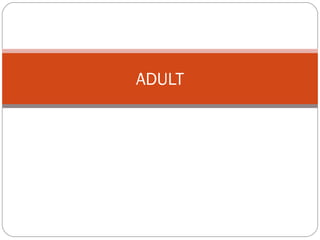Adult nutrition powerpoint
•Transferir como PPT, PDF•
30 gostaram•37,862 visualizações
Adults generally need fewer calories as they age, with recommended daily calorie intake ranges being 1600-2400 calories for those aged 23-50, 1400-2200 calories for ages 51-75, and 1200-2000 calories for ages 75 and above. Nutrient needs also change with age due to factors like declining organ function and changes in metabolism. Common health conditions that affect adults include heart disease, cancer, diabetes, osteoporosis, and prostate cancer, with risk influenced by diet and lifestyle habits. Meeting nutrition needs becomes more challenging for older adults due to physical and social factors.
Denunciar
Compartilhar
Denunciar
Compartilhar

Mais conteúdo relacionado
Mais procurados
Mais procurados (20)
Destaque
Destaque (14)
Nutritional assessment by Dr. Rajan Bikram Rayamajhi

Nutritional assessment by Dr. Rajan Bikram Rayamajhi
Food pyramid powerpoint diagrams and powerpoint templates

Food pyramid powerpoint diagrams and powerpoint templates
Semelhante a Adult nutrition powerpoint
Semelhante a Adult nutrition powerpoint (20)
Nutrition care of the denture patient/ orthodontic seminars

Nutrition care of the denture patient/ orthodontic seminars
Nutrition care of the denture patient/ dental implant courses

Nutrition care of the denture patient/ dental implant courses
Nutrition /certified fixed orthodontic courses by Indian dental academy 

Nutrition /certified fixed orthodontic courses by Indian dental academy
Elderly Assignment Due Tuesday, November 29, 201125 points + 15 .docx

Elderly Assignment Due Tuesday, November 29, 201125 points + 15 .docx
Geriatric nutrition- nutrition for optimal health, energy, and longevity in o...

Geriatric nutrition- nutrition for optimal health, energy, and longevity in o...
SESSION 8.3; NUTITIONAL REQUIRMENTS FOR ADULTS.pptx

SESSION 8.3; NUTITIONAL REQUIRMENTS FOR ADULTS.pptx
Mais de Abigail Abalos
Mais de Abigail Abalos (20)
Último
Book Paid Powai Call Girls Mumbai 𖠋 9930245274 𖠋Low Budget Full Independent H...

Book Paid Powai Call Girls Mumbai 𖠋 9930245274 𖠋Low Budget Full Independent H...Call Girls in Nagpur High Profile
Último (20)
Premium Call Girls Cottonpet Whatsapp 7001035870 Independent Escort Service

Premium Call Girls Cottonpet Whatsapp 7001035870 Independent Escort Service
Top Rated Bangalore Call Girls Mg Road ⟟ 8250192130 ⟟ Call Me For Genuine Sex...

Top Rated Bangalore Call Girls Mg Road ⟟ 8250192130 ⟟ Call Me For Genuine Sex...
Call Girls Ooty Just Call 9907093804 Top Class Call Girl Service Available

Call Girls Ooty Just Call 9907093804 Top Class Call Girl Service Available
Bangalore Call Girl Whatsapp Number 100% Complete Your Sexual Needs

Bangalore Call Girl Whatsapp Number 100% Complete Your Sexual Needs
VIP Service Call Girls Sindhi Colony 📳 7877925207 For 18+ VIP Call Girl At Th...

VIP Service Call Girls Sindhi Colony 📳 7877925207 For 18+ VIP Call Girl At Th...
Book Paid Powai Call Girls Mumbai 𖠋 9930245274 𖠋Low Budget Full Independent H...

Book Paid Powai Call Girls Mumbai 𖠋 9930245274 𖠋Low Budget Full Independent H...
Bangalore Call Girls Hebbal Kempapura Number 7001035870 Meetin With Bangalor...

Bangalore Call Girls Hebbal Kempapura Number 7001035870 Meetin With Bangalor...
Call Girls Siliguri Just Call 9907093804 Top Class Call Girl Service Available

Call Girls Siliguri Just Call 9907093804 Top Class Call Girl Service Available
VIP Mumbai Call Girls Hiranandani Gardens Just Call 9920874524 with A/C Room ...

VIP Mumbai Call Girls Hiranandani Gardens Just Call 9920874524 with A/C Room ...
VIP Russian Call Girls in Varanasi Samaira 8250192130 Independent Escort Serv...

VIP Russian Call Girls in Varanasi Samaira 8250192130 Independent Escort Serv...
Call Girls Bhubaneswar Just Call 9907093804 Top Class Call Girl Service Avail...

Call Girls Bhubaneswar Just Call 9907093804 Top Class Call Girl Service Avail...
Vip Call Girls Anna Salai Chennai 👉 8250192130 ❣️💯 Top Class Girls Available

Vip Call Girls Anna Salai Chennai 👉 8250192130 ❣️💯 Top Class Girls Available
Call Girls Coimbatore Just Call 9907093804 Top Class Call Girl Service Available

Call Girls Coimbatore Just Call 9907093804 Top Class Call Girl Service Available
Call Girls Nagpur Just Call 9907093804 Top Class Call Girl Service Available

Call Girls Nagpur Just Call 9907093804 Top Class Call Girl Service Available
Call Girls Service Jaipur Grishma WhatsApp ❤8445551418 VIP Call Girls Jaipur

Call Girls Service Jaipur Grishma WhatsApp ❤8445551418 VIP Call Girls Jaipur
Night 7k to 12k Navi Mumbai Call Girl Photo 👉 BOOK NOW 9833363713 👈 ♀️ night ...

Night 7k to 12k Navi Mumbai Call Girl Photo 👉 BOOK NOW 9833363713 👈 ♀️ night ...
Call Girl Number in Panvel Mumbai📲 9833363713 💞 Full Night Enjoy

Call Girl Number in Panvel Mumbai📲 9833363713 💞 Full Night Enjoy
Chandrapur Call girls 8617370543 Provides all area service COD available

Chandrapur Call girls 8617370543 Provides all area service COD available
High Profile Call Girls Coimbatore Saanvi☎️ 8250192130 Independent Escort Se...

High Profile Call Girls Coimbatore Saanvi☎️ 8250192130 Independent Escort Se...
Kesar Bagh Call Girl Price 9548273370 , Lucknow Call Girls Service

Kesar Bagh Call Girl Price 9548273370 , Lucknow Call Girls Service
Adult nutrition powerpoint
- 1. ADULT
- 2. How many calories does an adult need?
- 13. Average women with sedentary lifestyle CALORIES AGE 1600-2400 23-50 1400-2200 51-75 1200-2000 75 and above
- 14. Average men with sedentary lifestyle CALORIES AGE 2300-3100 23-50 2000-2800 51-75 1650-2450 75 and above
- 16. Effects of aging ORGAN INVOLVED CAUSED BY EFFECT ON NUTRITION Tongue and nose taste buds ability to taste salt and sweets taste and olfactory nerve endings Palatibility of food Food intake Taste and smell Salivary glands saliva production Reduced sense of thirst/dry mouth esophagus Muscle contractions may malfunction Difficulty chewing Stomach HCl secretion and intrinsic factor Bioavailability of vitamins, minerals, proteins Liver production of drug-matabolizing enzymes Adrug doses (adjustments possible to avoid overdosing)
- 30. DETERMINE
- 31. Adults are risk for….
- 33. COMMON DISEASES IN ADULTS
